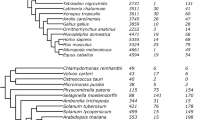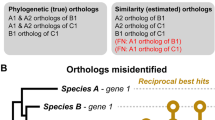Abstract
Given that a gene has a high (or low) synonymous substitution rate in one mammalian species, will it also have a high (or low) synonymous substitution rate in another mammalian species? Such similarities in the rate of synonymous substitution can reveal both selective pressures and neutral processes acting on mammalian gene sequences; however, the existence of such an effect has been a matter of disagreement. We resolve whether such synonymous substitution rate similarities exist using 7462 ortholog triplets aligned across rat, mouse, and human, a dataset two orders of magnitude larger than previous studies. We find that a gene’s synonymous substitution rate in the rat-mouse branch of the phylogeny is correlated with its rate in the branch connecting human and the rat-mouse ancestor. We confirm this for several different measures of synonymous substitution rate, including corrections for base composition and CpG dinucleotides, and we verify the results in the larger mouse-human-rat-dog phylogeny. This similarity of rates is most apparent for genes in which synonymous sites are well conserved across species, suggesting that a significant component of the effect is due to purifying selection. We observe rate correlations at a resolution as fine as a few hundred kilobases, and the genes with the most similar synonymous substitution rates are enriched for regulatory functions. Genes with above-average substitution rates also exhibit significant, though somewhat weaker, rate correlations, suggesting that some neutral processes may have persisted in the phylogeny as well.






Similar content being viewed by others
References
Altschul SF, Gish W, Miller W, Myers EW, Lipman DJ (1990) Basic local alignment search tool. J Mol Biol 215:403–410
Boffelli D, McAuliffe J, Ovcharenko D, Lewis KD, Ovcharenko I, Pachter L, Rubin EM (2003) Phylogenetic shadowing of primate sequences to find functional regions of the human genome. Science 299:1391–1394
Bulmer M, Wolfe KH, Sharp PM (1991) Synonymous nucleotide substitution rates in mammalian genes: implications for the molecular clock and the relationship of mammalian orders. Proc Natl Acad Sci U S A 88:5974–5978
Bustamante CD, Nielsen R, Hartl DL (2002) A maximum likelihood method for analyzing pseudogene evolution: implications for silent site evolution in humans and rodents. Mol Biol Evol 19:110–117
Castresana J (2002) Genes on human chromosome 19 show extreme divergence from the mouse orthologs and a high GC content. Nucleic Acids Res 30:1751–1756
Chamary JV, Hurst LD (2004) Similar rates but different modes of sequence evolution in introns and at exonic silent sites in rodents: evidence for selectively driven codon usage. Mol Biol Evol 21:1014–1023
Chamary JV, Hurst LD (2005) Evidence for selection on synonymous mutations affecting stability of mRNA secondary structure in mammals. Genome Biol 6:R75
Chamary JV, Parmley JL, Hurst LD (2006) Hearing silence: non-neutral evolution at synonymous sites in mammals. Nat Rev Genet 7:98–108
Chimpanzee Sequencing Consortium (2005) Initial sequence of the chimpanzee genome and comparison with the human genome. Nature 437:69–87
Chuang JH, Li H (2004) Functional bias and spatial organization of genes in mutational hot and cold regions in the human genome. PLoS Biol 2:E29
Cooper GM, Brudno M, Stone EA, Dubchak I, Batzoglou S, Sidow A (2004) Characterization of evolutionary rates and constraints in three mammalian genomes. Genome Res 14:539–548
Fairbrother WG, Holste D, Burge CB, Sharp PA (2004) Single nucleotide polymorphism-based validation of exonic splicing enhancers. PLoS Biol 2:E268
Gaffney DJ, Keightley PD (2005) The scale of mutational variation in the murid genome. Genome Res 15:1086–1094
Graur D, Li W-H (2000) Fundamentals of molecular evolution. Sinauer, Sunderland, MA
Hardison RC (2003) Comparative genomics. PLoS Biol 1:E58
Hardison RC, Roskin KM, Yang S, Diekhans M, Kent WJ, Weber R, Elnitski L, Li J, O’Connor M, Kolbe D, Schwartz S, Furey TS, Whelan S, Goldman N, Smit A, Miller W, Chiaromonte F, Haussler D (2003) Covariation in frequencies of substitution, deletion, transposition, and recombination during eutherian evolution. Genome Res 13:13–26
Hellmann I, Zollner S, Enard W, Ebersberger I, Nickel B, Paabo S (2003) Selection on human genes as revealed by comparisons to chimpanzee cDNA. Genome Res 13:831–837
Hurst LD, Pal C (2001) Evidence for purifying selection acting on silent sites in BRCA1. Trends Genet 17:62–65
Kudla G, Lipinski L, Caffin F, Helwak A, Zylicz M (2006) High guanine and cytosine content increases mRNA levels in mammalian cells. PLoS Biol 4:e180
Langley CH, Fitch WM (1974) An examination of the constancy of the rate of molecular evolution. J Mol Evol 3:161–177
Lercher MJ, Chamary JV, Hurst LD (2004) Genomic regionality in rates of evolution is not explained by clustering of genes of comparable expression profile. Genome Res 14:1002–1013
Mouchiroud D, Gautier C, Bernardi G (1995) Frequencies of synonymous substitutions in mammals are gene-specific and correlated with frequencies of nonsynonymous substitutions. J Mol Evol 40:107–113
Parmley JL, Chamary JV, Hurst LD (2006) Evidence for purifying selection against synonymous mutations in mammalian exonic splicing enhancers. Mol Biol Evol 23:301–309
Rat Genome Sequencing Consortium (2004) Genome sequence of the Brown Norway rat yields insights into mammalian evolution. Nature 428:493–521
Reich DE, Schaffner SF, Daly MJ, McVean G, Mullikin JC, Higgins JM, Richter DJ, Lander ES, Altshuler D (2002) Human genome sequence variation and the influence of gene history, mutation and recombination. Nat Genet 32:135–142
Schattner P, Diekhans M (2006) Regions of extreme synonymous codon selection in mammalian genes. Nucleic Acids Res 34:1700–1710
Smith NG, Hurst LD (1998) Molecular evolution of an imprinted gene: repeatability of patterns of evolution within the mammalian insulin-like growth factor type II receptor. Genetics 150:823–833
Smith NG, Webster MT, Ellegren H (2002) Deterministic mutation rate variation in the human genome. Genome Res 12:1350–1356
Springer MS, Murphy WJ, Eizirik E, O’Brien SJ (2003) Placental mammal diversification and the Cretaceous-Tertiary boundary. Proc Natl Acad Sci U S A 100:1056–1061
Steffen G, Sebastian B, Peter NR, Martin V (2006) An improved statistic for detecting over-represented gene ontology annotations in gene sets. Lecture Notes Comput Sci 3909:85–98
Williams EJ, Hurst LD (2002) Is the synonymous substitution rate in mammals gene-specific? Mol Biol Evol 19:1395–1398
Wolfe KH, Sharp PM, Li WH (1989) Mutation rates differ among regions of the mammalian genome. Nature 337:283–285
Xie X, Lu J, Kulbokas EJ, Golub TR, Mootha V, Lindblad-Toh K, Lander ES, Kellis M (2005) Systematic discovery of regulatory motifs in human promoters and 3’ UTRs by comparison of several mammals. Nature 434:338–345
Xing Y, Lee C (2005) Evidence of functional selection pressure for alternative splicing events that accelerate evolution of protein subsequences. Proc Natl Acad Sci U S A 102:13526–13531
Yang Z (1997) PAML: a program package for phylogenetic analysis by maximum likelihood. Comput Appl Biosci 13:555–556
Acknowledgments
This article was based upon work supported by the National Science Foundation under Postdoctoral Fellowship NSF-030698. Any opinions, findings, and conclusions or recommendations expressed in this publication are those of the authors and do not necessarily reflect the views of the National Science Foundation. JC thanks P. Arndt, C.S. Chin, S.L. Chen, J. Plotkin, and B. Tuch for comments on the manuscript. HL acknowledges support from NIH (grant GM 70808) and a David and Lucile Packard Fellowship.
Author information
Authors and Affiliations
Corresponding author
Additional information
Reviewing Editor: Dr. Richard Kliman
Electronic supplementary material
Electronic supplementary material
Rights and permissions
About this article
Cite this article
Chuang, J.H., Li, H. Similarity of Synonymous Substitution Rates Across Mammalian Genomes. J Mol Evol 65, 236–248 (2007). https://doi.org/10.1007/s00239-007-9008-x
Received:
Accepted:
Published:
Issue Date:
DOI: https://doi.org/10.1007/s00239-007-9008-x




